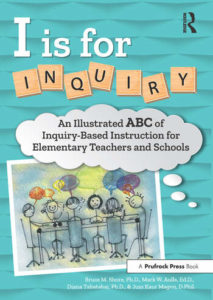An Illustrated ABC of Inquiry-Based Teaching
I Is for Inquiry: An Illustrated ABC of Inquiry-Based Instruction, 1st Edition
By Bruce M. Shore, Mark Wesley Aulls, Diana Tabatabai, and Juss Kaur Magon
(Routledge/Prufrock, 2020 – Learn more)
Reviewed by Michael McLaughlin


To animate the “minds to inquire” part of our mission, it’s important that educators cultivate a culture of curiosity. This doesn’t happen by accident – educators must be intentional about embedding inquiry-based teaching and learning strategies into their lessons and supporting students in embracing a learning mindset.
I Is for Inquiry by Bruce Shore, Mark Wesley Aulls, Diana Tabatabai, and Juss Kaur Magon presents a diverse repertoire of concepts to help teachers infuse inquiry into their curriculum in a practical, approachable way.
What is Inquiry?
The authors describe inquiry as an act of investigation or exploration in which the inquirer is involved in “finding out something new because we want to know it, not just because we have to.”
Classrooms that promote inquiry are collaborative environments and a hub of activity. In these classrooms, content, skills, and application are derived from students’ curiosity. Students and educators co-construct curriculum and goals. To cultivate a life-long passion for learning and the ability to pursue questions, students must have many and diverse experiences they can investigate in school.
I Is for Inquiry presents 26 key concepts of inquiry-based pedagogy. Common to all the concepts is a student-centered approach: students are guided in their pursuit of questions and are fueled by an enthusiasm for not just discovering answers to questions but more so by their capacity to pose new ones.
This active approach to education is rooted in over a century of research – from Dewey and Piaget to Vygotsky – and is one situated for the 21st Century in which students must be prepared to apply, create, and innovate.
Approachable Chapter Framework
The brevity, structure, and content of the book’s 26 chapters make I Is for Inquiry an accessible resource that educators can reference throughout the school year.
Every chapter is a quick read – ten to fifteen minutes. The brevity allows teachers to quickly digest a concept and still have prep time to embed a suggested strategy or two into a lesson. An appendix of resources, including video, provides opportunities for a deeper dive if time allows or if circling back to the concept for the second or third time.
The consistent chapter layout organizes the information about each topic in a manner tailor-made for teachers looking to put theory into immediate practice.
Each chapter opens with a unique and whimsical illustration. Letters are transformed into a fun piece of art meant to draw readers in and capture more about each concept. For example, H represents Hypothesis. The H is incorporated into a map with multiple routes and illustrates the “what happens if” question that drives hypothetical thinking. Likewise, P represents Process. The letter P is depicted as a person walking methodically up a flight of stairs – taking one step at a time.
For visual learners, the illustrations are another way to access the concepts presented in the book. Further, in empowering students to exercise metacognition and think about thinking, the illustrations can be used as a teaching tool to initiate dialogue about the various inquiry-based strategies.
Chapters include several key features.
- A concise definition sets the stage.
- A description or story, often rooted in research literature but distilled for practitioners, highlights how to implement the concept.
- A paragraph summary at the end of the chapter narrative makes a compelling case for why the strategy is important.
- Lastly, a curated list of video resources and further reading invite continued investigation about each topic and avenues to put the concept into action.
For example, the six-page chapter “R is for Roles” explores the behaviors and responsibilities of teachers and students in whole-class, small-group, paired, and individual instruction. The chapter outlines a framework for students to assume diverse social and academic roles throughout inquiry-based activities found in other chapters in the book. A table of roles and exemplar videos help educators to visualize how to animate the practice into their next lesson or enhance current pedagogy.
Beyond the Elementary Grades
Although I Is for Inquiry is presented as an ABC-style resource for elementary school teachers, I found the guide useful for conversations about inquiry-based instructional practices at the middle and upper school levels. The accessible way each concept is presented nurtures educators with a digestible concept. Though many of the exemplar “see it in action” videos and resources are elementary-based, a number of middle and high school examples broaden the potential audience for this book.
From Activity to Zone of Proximal Development, the authors have crafted a helpful resource for educators to bring greater intentionality to their work of inspiring minds to inquire.
Michael McLaughlin is the Head of Middle School at Austin Preparatory School in Reading, Massachusetts. The 2019 recipient of the A+ Administrator Award from the New England League of Middle Schools (NELMS), McLaughlin also facilitates workshops for the Salem State Collaborative Project and has appeared on “The Teacher As” podcast. McLaughlin is on the NELMS Board of Directors and on the advisory board of Buckingham Education in the United Kingdom.


































